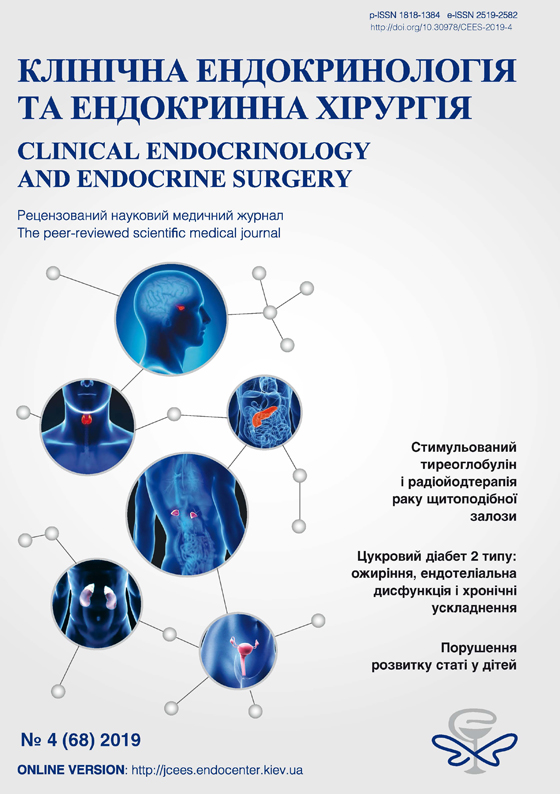Зв’язок сироваткових рівнів маркерів ендотеліальної дисфункції з ускладненнями цукрового діабету 2-го типу
DOI:
https://doi.org/10.30978/CEES-2019-4-53Ключові слова:
цукровий діабет 2-го типу, ускладнення, ендотеліальна дисфункціяАнотація
Ендотеліальна дисфункція (ЕДФ) формується при цукровому діабеті 2-го типу (ЦД2) і в подальшому бере участь у патогенезі захворювання. Основними маркерами ЕДФ є гормон ендотелію — ендотелін (ЕТ1), азоту оксид (NO), ендотеліальна NO-синтаза (eNOS), фактор некрозу пухлин альфа (TNF-α) і маркер оксидантного стресу – дієнові кон’югати (ДК). Мета роботи — встановити зв’язок сироваткових рівнів маркерів ЕДФ (ЕТ1, eNOS, NO, TNF-α, ДК) з ускладненнями ЦД2. Матеріали та методи. Обстежили 152 пацієнтів з ЦД2 та 95 практично здорових осіб (контрольна група). За результатами клініко-лабораторних обстежень встановлювали стадію захворювання та виявляли наявність ускладнень. У плазмі крові визначали вміст ЕТ1 (Biomedica Immunoassays, Австрія), eNOS (BCM Diagnostics, США) і TNF-α (Bender Medsystems, Австрія). Вміст у крові NO визначали за його кінцевими метаболітами (NOx) у реакції Гриса, рівень ДК ненасичених жирних кислот — за Z. Placer у модифікації В. Б. Гаврилова. Для статистичної обробки отриманих даних використовували програму Statistica 10 (StatSoft, Inc., USA). Результати та обговорення. Вміст у крові ЕТ1, TNF-α, NOх та ДК багаторазово достеменно підвищувався, що відповідало тяжкості захворювання (особливо TNF-α і ЕТ1), рівень eNOS — знижувався. Концентрація ЕТ1 вище 1,990 фмоль/мл асоціювалася з нефропатію за рівнем мікроальбумінурії, а вище 2,309 фмоль/мл — з розвитком інших ускладнень. Зростання вмісту в крові TNF-α вище 102 і 105,1 пг/мл визначало ретинопатію та нефропатію відповідно. Розвиток нефропатії за рівнем мікроальбумінурії, крім ЕТ1, підтверджував зниження вмісту в крові eNOS нижче 250,4 пг/мл та ДК нижче 5,368 Од/мл. Для всіх маркерів встановлено критичні рівні для формування макроангіопатії нижніх кінцівок та майже для всіх (крім eNOS) — артеріальної гіпертензії. Висновки. Встановлено зв’язок маркерів ЕДФ з ускладненнями ЦД2 і визначено критичні значення, що свідчать про принципову можливість застосування маркерів (особливо ЕТ1 і TNF-α) для прогнозування розвитку ускладнень ЦД2.Посилання
Pi X, Xie L, Patterson C. Emerging Roles of Vascular Endothelium in Metabolic Homeostasis. Circ Res. 2018;123(4):477-494. doi: 10.1161/CIRCRESAHA. 118.313237.
Kuznetsova AS, Gozhenko AI, Kuznetsova ES et al. Endothelium. Physiology and pathology: monograph. Odessa: Fenix, 2018:284 [in Russian].
Cutiongco MFA, Chua BMX, Neo DJH et al. Functional differences between healthy and diabetic endothelial cells on topographical cues. Biomaterials. 2018;153:70-84. doi: 10.1016/j.biomaterials. 2017.10.037.
Blum A, Socea D, Sirchan R. Vascular responsiveness in type 2 diabetes mellitus (T2DM). QJM. 2016;109(12):791-796. doi: 10.1093/qjmed/hcw081.
Polovina MM, Potpara TS. Endothelial dysfunction in metabolic and vascular disorders. Postgrad Med. 2014;126(2):38-53. doi: 10.3810/pgm.2014.03.2739.
Carrizzo A, Izzo C, Oliveti M et al. The Main Determinants of Diabetes Mellitus Vascular Complications: Endothelial Dysfunction and Platelet Hyperaggregation. Int J Mol Sci. 2018;19(10):E2968. doi: 10.3390/ijms19102968.
Babik B, Peták F, Agócs S et al. Diabetes mellitus: endothelial dysfunction and changes in hemostasis. Orv Hetil. 2018;159(33):1335-1345. doi: 10.1556/650.2018.31130. In Hungarian
Raminderjit K, Manpreet K, Jatinder Singhcorresponding. Endothelial dysfunction and platelet hyperactivity in type 2 diabetes mellitus: molecular insights and therapeutic strategies. Cardiovasc Diabetol. 2018;17:121. doi: [10.1186/s12933-018-0763-3].
Bermejo-Martin JF, Martín-Fernandez M, López-Mestanza C et al. Shared Features of Endothelial Dysfunction between Sepsis and Its Preceding Risk Factors (Aging and Chronic Disease). J Clin Med. 2018;7(11):E400. doi: 10.3390/jcm7110400.
Knapp M, Tu X, Wu R. Vascular endothelial dysfunction, a major mediator in diabetic cardiomyopathy. Acta Pharmacol Sin. 2018;Jun 4. doi: 10.1038/s41401-018-0042-6.
Ziablitsev SV, Chernobryvtsev OP, Ziablitsev DS, Starodubska OO. Pathogenetic role of endothelin-1 and polymorphism of its receptors in type 2 diabetes. Fiziol Zh. 2019;65(2):22-30. [in Ukrainian].
Ziablytsev SV, Chernobryvtsev OP, Ziablytsev DS. Significance of alpha tumor necrosis factor in the development of nephropathy in type 2 diabetes mellitus. Clinical endocrinology and endocrine surgery. 2019;65(1):72-80. [in Ukrainian].
Ziablytsev SV, Chernobryvtsev OP, Zyablytsev DS. Indicators of endothelial dysfunction in type 2 diabetes mellitus as determinative factors of development of complications. International Endocrine Journal. 2018;4(7):661-7. [in Ukrainian].
Pankiv VI. Diabetes mellitus: diagnostic criteria, etiology and pathogenesis. International Endocrinology Journal. 2013;8(56):53-64. [in Ukrainian].
Type 2 Diabetes Complications. Web-resource: www.endocrineweb.com/ conditions/type-2-diabetes.
KDIGO 2012 Clinical Practice Guideline for the Evaluation and Management of Chronic Kidney Disease. Kidney Int. Suppl. 2013;3(1):1-150.
Zanatta CM, Crispim D, Sortica DA et al. Endothelin-1 gene polymorphisms and diabetic kidney disease in patients with type 2 diabetes mellitus. Diabetol Metab Syndr. 2015;7:103. doi: 10.1186/s13098-015-0093-5.
Li W, Abdul Y, Ward R, Ergul A. Endothelin and diabetic complications: a brain-centric view. Physiol Res. 2018;67 (Suppl. 1):S83–S94.
Bregar D, Cilenšek I, Mankoč S et al. The joint effect of the endothelin receptor B gene (EDNRB) polymorphism rs10507875 and nitric oxide synthase 3 gene (NOS3) polymorphism rs869109213 in Slovenian patients with type 2 diabetes mellitus and diabetic retinopathy. Bosn J Basic Med Sci. 2018;18(1):80-86. doi: 10.17305/bjbms.2017.2244.
Georgianos PI, Agarwal R Endothelin A receptor antagonists in diabetic kidney disease. Curr Opin Nephrol Hypertens. 2017;26(5):338-344. doi: 10.1097/MNH.0000000000000342.
Lian K, Guo X, Huang Q et al. Reduction Levels and the Effects of High-Molecular-Weight Adiponectin via AMPK/eNOS in Chinese Type 2 Diabetes. Exp Clin Endocrinol Diabetes. 2016;124(9):541-547. doi: 10.1055/s-0042-109262.
Banerjee M, Vats P. Reactive metabolites and antioxidant gene polymorphisms in Type 2 diabetes mellitus. Redox Biol. 2014;2:170-177. doi: 10.1016/j.redox.2013.12.001.
Liu C, Feng X, Li Q et al. Adiponectin, TNF-α and inflammatory cytokines and risk of type 2 diabetes: A systematic review and meta-analysis. Cytokine. 2016;86:100109. doi: 10.1016/j.cyto.2016.06.028.
Copps KD, White MF. Regulation of insulin sensitivity by serine/threonine phosphorylation of insulin receptor substrate proteins IRS1 and IRS2. Diabetologia. 2012;55(10):2565-2582. doi:10.1007/s00125-012-2644-8.
Takaguri A. Elucidation of a new mechanism of onset of insulin resistance: effects of statins and tumor necrosis factor-α on insulin signal transduction. Yakugaku Zasshi. 2018;138(11):1329-1334. doi: 10.1248/yakushi.18-00116. [In Japanese].
Ziablitsev SV, Mokrii VY, Cristal MV. The value of polimorfism Pro12Ala gene in violation of lipid peroxidation and antioxidant protection in patient with type 2 diabetes mellitus. Journal of Education, Health and Sport formely of Health Sciences. 2016;6(9):626-636.
##submission.downloads##
Опубліковано
Як цитувати
Номер
Розділ
Ліцензія
Авторське право (c) 2019 Клінічна ендокринологія та ендокринна хірургія

Ця робота ліцензується відповідно до Creative Commons Attribution 4.0 International License.





